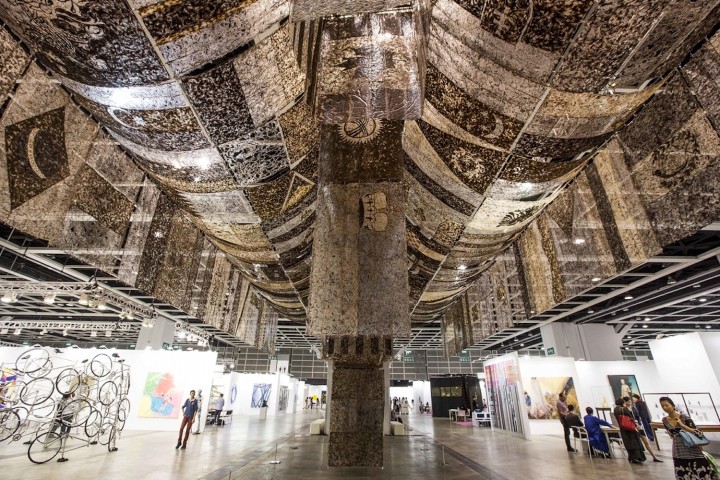Recently appointed director of the Asian branch of Art Basel, Adeline Ooi discusses her efforts to represent the art world across all of Asia — from Turkey to Japan.
There are many changes this year at Art Basel Hong Kong: first the dates, and secondly your appointment as director. How is this edition coming along?
This year’s edition of Art Basel in Hong Kong presents the strongest selection of galleries to date. As a result of the new March dates, nineteen leading galleries from Europe and the United States are able to attend for the first time. These include Andrea Rosen Gallery (New York), Esther Schipper (Berlin), Galerie Thomas (Munich), Kamel Mennour (Paris) and Skarstedt (New York). At the same time, we continue to be dedicated to showing the best art from Asia. Once again, fifty percent of our galleries have exhibition spaces in Asia and the Asia-Pacific region.
Previously you were director of an art gallery. Now that you are in charge of an art fair, how do the responsibilities differ?
While in the past my main focus was on South East Asia, my new role sees me represent work across all of Asia — from Turkey to India via Japan and New Zealand. Throughout my career I have worked with different groups within the art world. Sometimes the focus was more on artists and gallerists, and at other times more on private collectors, curators and museum directors. As Director Asia for Art Basel, and with the support of my team, I engage with all these different stakeholders at the same time.
You started working as a curator at Valentine Willie Fine Art. Are “curated” shows essential to the art fair context?
Curated shows and specially curated booths at art fairs give visitors an opportunity to see an alternative vision, a new approach to a particular artist, theme or artistic movement. Art Basel in Hong Kong also has two curated sectors: Encounters and Film. Alexie Glass-Kantor will be curating Encounters under the theme of “Landscape Urbanism,” with this year’s edition presenting twenty artworks, some of which have never been seen previously. Li Zhenhua’s selection for the film program explores seven different themes — urbanity; minor revolution; healing; nowhere; re-perform, re-construct, re-present; animated reality; and goddess — with over thirty-eight works on show.
You were appointed director of Art Basel Hong Kong only ten weeks before the opening of the current edition. Did you have time to work on a new section or layout?
When I was appointed eighty percent of the show was already in place: the galleries had been selected, the floor plan and placement had been finalized, etc. But I have been able to support the team in finalizing talks and event programming for the show. I don’t think the show needs immediate innovation. We are in a very good place, and I am thankful that I have the opportunity to witness how an art fair of this size and scale comes together — it is important for me to understand the nuts and bolts of it before trying to think about making changes. For now I’m happy to watch, learn and see how this year goes.
Do you have to work out the differences and similarities between the Basel, Miami and Hong Kong editions?
From my perspective, I think all three fairs serve the respective regions they operate in and are international in their reach. Nevertheless, they all demonstrate very different characters — in many ways this can be due to their locale. What is unique about each show is that it has a strong flavor of the region it is located in, and this is represented by the fact that half the galleries exhibiting in Hong Kong have exhibition spaces in Asia and the Asia-Pacific region. Similarly, you will find that at Art Basel over fifty percent of the exhibitors have spaces in Europe, and in Miami Beach fifty percent have spaces in the Americas. Not only that, but our events programming strives to give our visitors a sense of the city; as much as we want you to spend time in the halls, we would also like you to experience Hong Kong, to get a sense of the city and its local art community through visits to Chai Wan, Fotan Artists Studios, Parasite, South Island Art District, etc.
I suppose you will now move to Hong Kong. How do you see the city’s artistic community growing? What are the most relevant issues?
I am in the process of moving to Hong Kong, and I know the city well from traveling back and forth. Hong Kong’s art scene has been steadily growing over the past years. There is a strong community of collectors, local supporters and audience, as well as the presence of institutions and non-profits; these are key factors that indicate a dynamic, burgeoning scene. The arrival of a number of major international galleries in Hong Kong has also added another dimension to the scene. It tells us that the city is taken very seriously as one of the major Asian art hubs. But like any other city, every art scene is not without its challenges. Space is always a challenge in Hong Kong. That said, Hong Kong is a community of resilient and passionate people. I am also very excited about M+ and can’t wait for their building to be ready. I think they will be a great addition to Hong Kong.
What do you think are the most important factors in order to have a successful art fair?
I can only really speak about Art Basel. I think what makes Art Basel so successful is the focus on quality — from the galleries and their artists, to the programming of our talks and events program. This in turn attracts collectors, museum directors, curators and critics from across the world. We are also continuously looking at how we can further improve the platforms we are offering to our galleries.

